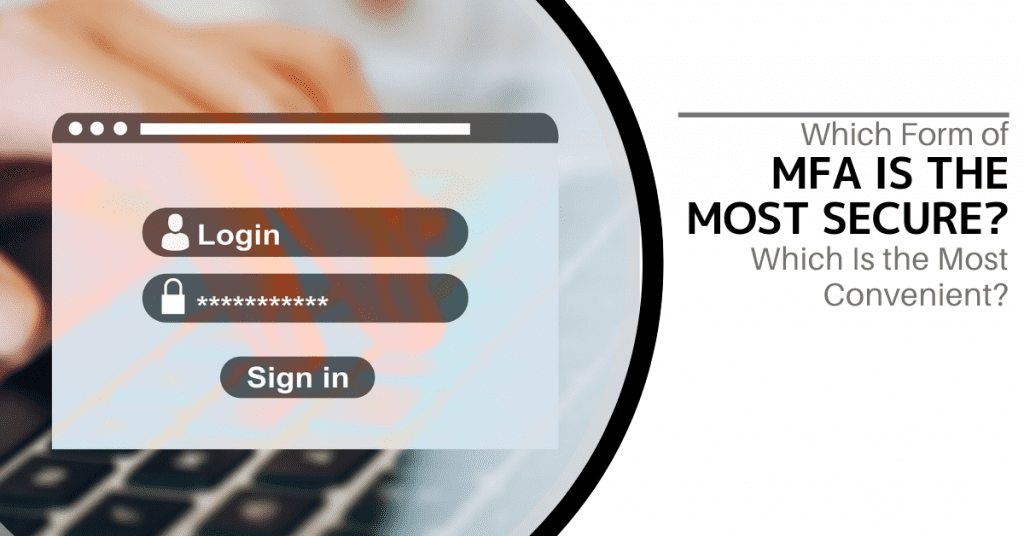Which Form of Multi-Factor Authentication Is the Most Secure?

Implementing effective identity and access management measures is a top priority for professionals and businesses alike. Nevertheless, finding the best measures to ensure security, control, and effectiveness might be challenging. Multi-factor authentication (MFA) is one of the most effective security measures on the market today.
MFA has become a trusted way of ensuring identity and access management security across industries and organizations. This discussion will focus on the most secure and convenient forms of MFA so that professionals and organizations can choose the right option for their needs.
What Is Multi-Factor Authentication?
Multi-factor authentication (MFA) is a type of identity and access management protocol that ensures secure access to devices and information. MFA aims to help protect devices, networks, and information from intruders seeking to gain unauthorized access.
Using MFA protocols has become commonplace over the last few years. More and more organizations have relied on MFA to ensure secure identity and access management. However, using MFA systems may cause accessing devices and networks to become a slow process. It is, therefore, important to find the most secure yet convenient way of ensuring access to networks and devices.
What Are the Types of Multi-Factor Authentication?
There are types of MFA protocols currently in use. The most common is two-factor authentication. In two-factor authentication, a user must access two separate devices to log in. For example, users must input their password into a computer and then input a one-time access code relayed to their mobile phone.
Here are other forms of two-factor authentication:
- Biometrics. Biometrics combines physical data such as voice activation, fingerprints, facial recognition, or retina scan.
- Random key generating apps. These apps generate random-access keys that users must input every time they access a network or device. Generally, these apps are loaded onto a secondary device such as a mobile phone, tablet, or another computer.
- SMS-based authentication. In this method, users get an SMS message on their phones through a third-party app.
- Standalone tokens. Standalone tokens are individual devices that generate random-access keys. These devices are not linked to phones or computers. Moreover, these tokens can generate keys are specified intervals, such as every hour.
Some of the most aggressive security measures automatically log users out of the network or devices at random intervals. Users must then log back in using the MFA method prescribed by their cybersecurity measures.
What Is the Most Secure Multi-Factor Authentication Method?
Unfortunately, all MFA protocols are subject to some vulnerability. For instance, key generating apps may be hacked. Sophisticated cybercriminals may even intercept SMS messages. While there is no entirely foolproof MFA method, the most secure MFA method is using an individual’s biometric information.
On the whole, biometrics are the most secure MFA method. Since biometrics are linked to a person’s unique physical features (facial and voice recognition, retina scans, and fingerprints), it is virtually impossible to impersonate fingerprints, retinas, or voice.
Using biometrics can get somewhat complex and pricey depending on the level of sophistication. The most sophisticated security features may require a fingerprint, password, and random key. This approach, however, may require a significant investment in the infrastructure needed to run it. For professionals and organizations looking for the most secure identity and access management method available, it is the most secure.
What Is the Most Convenient Multi-Factor Authentication Method?
The most convenient MFA method is any type of one-time code or key access linked to a mobile phone. Since virtually everyone owns a mobile phone, it is easy to receive codes or tokens to a phone. Users can easily use two-factor authentication easily and effectively. On the whole, using a mobile phone is a secure method. Nevertheless, mobile phones may be vulnerable to data breaches. Thus, this MFA method is useful when a minimal security level is needed.
What Is the Least Secure Multi-Factor Authentication Method?
Please note that email authentication is the least secure MFA method. Email is the most vulnerable method to hacking or data breaches. Nevertheless, the email could be part of a three-factor authentication that combines passwords, key-generating devices, and email.
It is always best to avoid using channels such as free email accounts (Gmail or Yahoo), messaging services (WhatsApp or Telegram), and social media platforms as a secondary authentication method. These channels are highly vulnerable to hacking. Consequently, they are the least secure MFA methods.
Are Standalone Tokens a Secure Multi-Factor Authentication Method?
Standalone tokens do not require a connection to any devices such as a mobile phone or another computing device. Standalone devices like a YubiKey or Thetis can offer very good identity and access management tools. They provide random keys at specified intervals users need to access computers and networks. The keys are programmed into devices and networks so that access points recognize the one-time codes as they are generated.
Nevertheless, there is a drawback. Standalone key generating devices can get pricey, especially if a large number of users require access to one. Additionally, the loss of a device may compromise the entire network requiring network and individual device reprogramming. Despite its drawbacks, standalone key-generating devices are the most secure due to their simplicity.
Conclusion
There should be no compromise between identity and access management. Using tools such as biometrics is the most secure MFA method on the market. Cost-effective biometric solutions such as fingerprint access can go a long way toward ensuring a high degree of network and device security.
Please remember that the worst MFA method is not having one at all. Utilizing a two-factor authentication approach combining a mobile phone and password access is enough to ensure a minimum level of security. Ultimately, starting with a simple MFA method is best and working up to a more secure and robust MFA method as needed.


